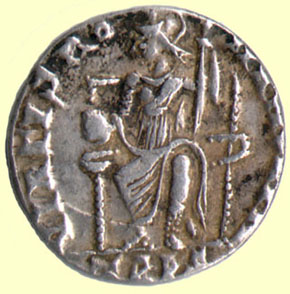 Contents -
Previous Article -
Next Article
Contents -
Previous Article -
Next Article
See also Imperial Government Officials and The Consistory
The seated figure illustrated on the coin at right is Roma, a personnification of the City of Rome. The legend reads Virtus Romanorum, or "The Valor of the Romans" The coin is a siliqua of Magnus Maximus, Master General of Valentinian II who murdered his emperor and seized the throne instead. Maximus' big mistake was murdering Valentinian. He probably would not have incurred the wrath of Theodosius and could have gone on to rule the West in deed if not in name had he not murdered the powerful Eastern emperor's brother - in - law.
The MAGISTER MILITVM, or Master General was the military magistrate or officer in charge of the large mobile field army of the late Roman Empire known as the Comitatensis. During certain periods of time, there were two masters general, the MAGISTER PEDITVM or master of foot soldiers and MAGISTER EQVITVM, or master of cavalry (troops who fought from horseback). Later, the two were combined in the office of MAGISTER UTRUISQUE MILITVUM or simply MAGISTER MILITVM.
The Frankish general Arbogastes was the magister militum of Valentinian II who is strongly suspected of murdering him. Flavius Stilicho and Flavius Aetius were perhaps the two most famous magistri militum in history. Stilicho was magister militum to Honorius and Aetius served Valentinian III. Because the magistri militvm held such vast and almost absolute power, they often ruled the Roman Empire in every way but name only in the case of weak or incompetent emperors Also because these two men were so powerful during the reigns of weak emperors, they are the center of controversy amongst historians even to this day. Some have hailed Stilicho and Aetius as faithful imperial servants, protectors of the Roman Empire and way of life during times of crisis. Other historians have branded them as nothing more than opportunistic thugs who would have murdered their emperors after they no longer had a need for them.
By the late Fourth Century, a powerful general who wanted to rule the Roman Empire usually kept the emperor as a puppet rather than kill him and take the throne. The Roman senatorial aristocracy would be more likely to cooperate with a powerful general and his puppet emperor than a German barbarian who ruled the empire directly. This type of racism in the Fourth Century A.D. had a slightly different flavor than it does in modern times, but it begat the same social ills of mistrust between the races and oppression of minorities. The difference was that the blonde haired, blue eyed Germans were discriminated against by the short, dark skinned Italians of old civilized families.
Go to next article:
Go back to previous article: